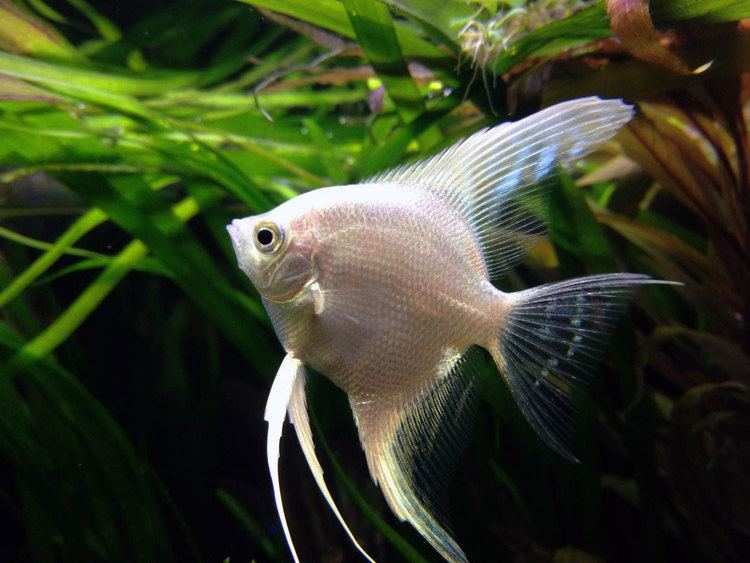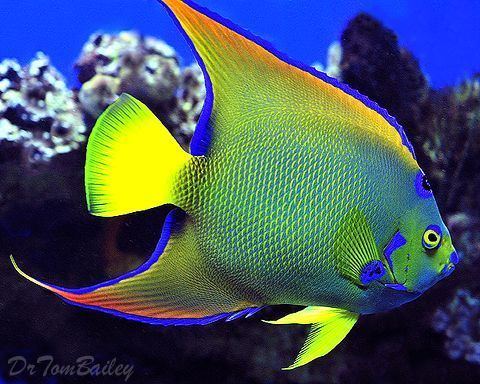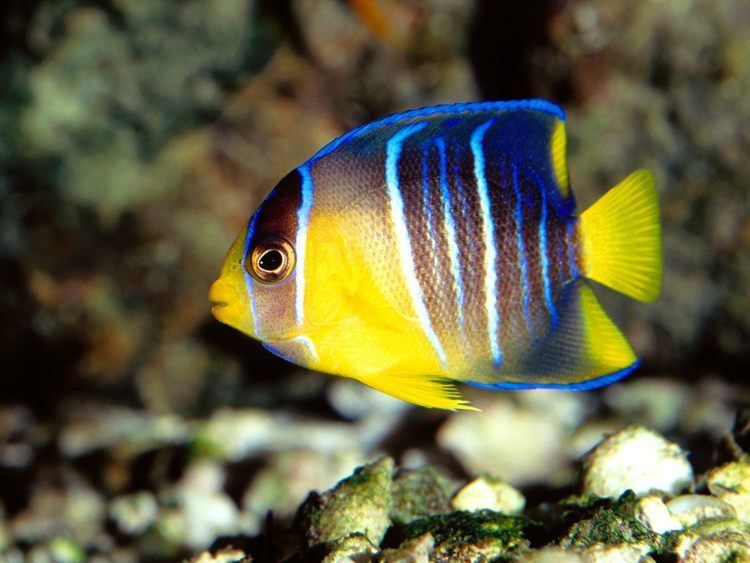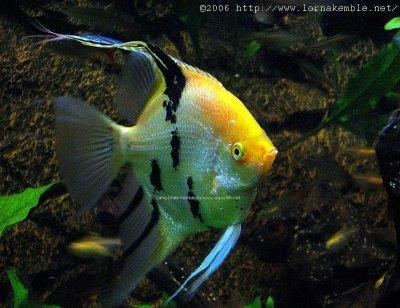Order Perciformes Higher classification Heroini | Phylum Chordata Scientific name Pterophyllum Rank Genus | |
 | ||
Length Pterophyllum leopoldi: 5 cm Lower classifications Freshwater angelfish, Pterophyllum altum, Pterophyllum leopoldi | ||
Fishing pterophyllum altum in atabapo
Pterophyllum is a small genus of freshwater fish from the family Cichlidae known to most aquarists as "angelfish". All Pterophyllum species originate from the Amazon Basin, Orinoco Basin and various rivers in the Guiana Shield in tropical South America. The three species of Pterophyllum are unusually shaped for cichlids being greatly laterally compressed, with round bodies and elongated triangular dorsal and anal fins. This body shape allows them to hide among roots and plants, often on a vertical surface. Naturally occurring angelfish are frequently striped longitudinally, colouration which provides additional camouflage. Angelfish are ambush predators and prey on small fish and macroinvertebrates. All Pterophyllum species form monogamous pairs. Eggs are generally laid on a submerged log or a flattened leaf. As is the case for other cichlids, brood care is highly developed.
Contents
- Fishing pterophyllum altum in atabapo
- Fishing pterophyllum altum venezuela 2012
- Species
- History
- In the aquarium
- Care
- Breeding
- Compatibility with other fish
- Aquarium varieties
- References

Fishing pterophyllum altum venezuela 2012
Species
The currently recognized species in this genus are:
History

The freshwater angelfish (P. scalare) was described in 1824 by F. Schultze. Pterophyllum is derived from the Greek πτερον, pteron (fin/sail) and φυλλον, phyllon (leaf).

In 1906, J. Pellegrin described P. altum. In 1963, P. leopoldi was described by J. P. Gosse. Undescribed species may still exist in the Amazon Basin. New species of fish are discovered with increasing frequency, and, like P. scalare and P. leopoldi, the differences may be subtle. Scientific notations describe the P. leopoldi as having 29–35 scales in a lateral row and straight predorsal contour, whereas, P. scalare is described as having 35–45 scales in a lateral row and a notched predorsal contour. P. leopoldi shows the same coloration as P. scalare, but a faint stripe shows between the eye stripe and the first complete body stripe and a third incomplete body stripe exists between the two main (complete) body stripes that extends three-fourths the length of the body. P. scalare's body does not show the stripe between the eye stripe and first complete body stripe at all, and the third stripe between the two main body stripes rarely extends downward more than a half inch, if even present. P. leopoldi fry develop three to eight body stripes, with all but one to five fading away as they mature, whereas P. scalare only has two in true wild form throughout life.
Angelfish were bred in captivity for at least 30 years prior to P. leopoldi being described.
In the aquarium

Angelfish are one of the most commonly kept freshwater aquarium fish, as well as the most commonly kept cichlid. They are prized for their unique shape, color and behavior. It was not until the late 1920s to early 1930s that the angelfish was bred in captivity in the United States.
Species
The most commonly kept species in the aquarium is Pterophyllum scalare. Most of the individuals in the aquarium trade are captive-bred. Sometimes, captive-bred Pterophyllum altum is available. Pterophyllum leopoldi is the hardest to find in the trade.
Care
Angelfish are kept in a warm aquarium, ideally around 80 °F (27 °C). Though angelfish are members of the cichlid family, they are generally peaceful when not mating; however, the general rule "big fish eat little fish" applies.
Breeding
P. scalare is relatively easy to breed in the aquarium, although one of the results of generations of inbreeding is that many breeds have almost completely lost their rearing instincts, resulting in the tendency of the parents to eat their young. In addition, it is very difficult to accurately identify the gender of any individual until it is nearly ready to breed.
Angelfish pairs form long-term relationships where each individual will protect the other from threats and potential suitors. Upon the death or removal of one of the mated pair, breeders have experienced both the total refusal of the remaining mate to pair up with any other angelfish and successful breeding with subsequent mates.
Depending upon aquarium conditions, P. scalare reaches sexual maturity at the age of six to 12 months or more. In situations where the eggs are removed from the aquarium immediately after spawning, the pair is capable of spawning every seven to 10 days. Around the age of three years, spawning frequency decreases and eventually ceases.
When the pair is ready to spawn, they choose an appropriate medium upon which to lay the eggs, and spend one to two days picking off detritus and algae from the surface. This medium may be a broad-leaf plant in the aquarium, a flat surface such as a piece of slate placed vertically in the aquarium, a length of pipe, or even the glass sides of the aquarium. The female deposits a line of eggs on the spawning substrate, followed by the male, which fertilizes the eggs. This process is repeated until a total of 100 to more than 1,200 eggs are laid, depending on the size and health of the female fish. As both parents care for the offspring throughout development, the pair takes turns maintaining a high rate of water circulation around the eggs by swimming very close to the eggs and fanning them with their pectoral fins. In a few days, the eggs hatch and the fry remain attached to the spawning substrate. During this period, the fry survive by consuming the remains of their yolk sacs. At one week, the fry detach and become free-swimming. Successful parents keep close watch on the eggs until then. At the free-swimming stage, the fry can be fed suitably sized live food.
P. altum is notably difficult to breed in an aquarium environment.
Compatibility with other fish
In pet stores, the freshwater angelfish is typically placed in the semiaggressive category. Some tetras and barbs are compatible with angelfish, but ones small enough to fit in the mouth of the angelfish may be eaten. Generous portions of food should be available so the angelfish do not get hungry and turn on their tank mates.
Aquarium varieties
Most strains of angelfish available in the fishkeeping hobby are the result of many decades of selective breeding. For the most part, the original crosses of wild angelfish were not recorded and confusion between the various species of Pterophyllum, especially P. scalare and P. leopoldi, is common. This makes the origins of "domestic angelfish" unclear. Domestic strains are most likely a collection of genes resulting from more than one species of wild angelfish combined with the selection of mutations in domesticated lines over the last 60 or more years. The result of this is a domestic angelfish that is a true hybrid with little more than a superficial resemblance to wild Pterophyllum species. Much of the research into the known genetics of P. scalare is the result of the research of Dr. Joanne Norton, who published a series of 18 articles in Freshwater and Marine Aquarium Magazine.
